The master bedroom of a UK suburban house in the 1940s
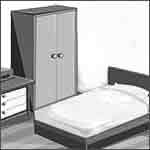
There were no new housing estates in the UK in the 1940s because all the country’s resources went into the war effort and the recovery afterwards. The newest mass housing was built as housing estates in the late 1930s. This page describes the master bedroom and its furnishings in a typical such house as it was in the 1940s.
____
By the webmaster, based childhood observations, discussions with people who lived in these houses and additional research
The bedroom suite
In some houses, the bedroom furniture was made up of hand-me-downs, but my parents married quite late and managed to buy a buy a bedroom suite just before war broke out. It was very dark oak in the fashion of the time, and I felt that the complete suite of double bed, two bedside cabinets, a dressing table, a wardrobe and two chests of drawers seemed to take up the whole room, making it look dismal.
The wood was all solid not veneered, and certainly not a plastic look-alike, as there were no such plastics at that time. The solid wood of the 1940s - and indeed of previous years - never had the clear-cut edges of modern veneered wood or plastic look-alikes, so always tended to look rather tatty. However, we knew no different, and my mother polished all the wooden surfaces repeatedly with Mansion Polish which made them shine.
The wardrobe
The wardrobe was essentially just a cupboard with two doors and a rail inside. It had no mirror. My father's day-to-day clothes hung on the left and my mother's on the right. (Fortunately there was a large built-in cupboard in the second bedroom and another on the landing which took care of the overflow.)
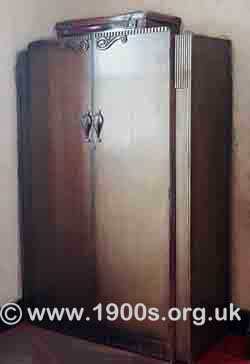
Dark oak, two-door wardrobe, photographed at Tilford Rural Life Centre.
The chests of drawers
The small chest of drawers was for my father's underwear and his various other odds and ends.
The larger chest of drawers contained various day-to-day linens such as towels, table cloths, and sheets, as well as my mother's underwear and other odds and ends. (Towels and sheets in regular use were stored in the airing cupboard in the bathroom, and other linens were stored in the built-in cupboards in the second bedroom and the landing.)
The dressing table
The dressing table had three mirrors: a main one and two at the side. They always fascinated me as a child because if I poked my head in close enough and pulled the side mirrors so that they faced each other, I could see reflections of myself going on forever. In fact, though, the mirrors were primarily for effect rather than function because it was impossible to get close enough to them in the normal way. Solid drawers prevented that, and there was no inset for a chair or stool.
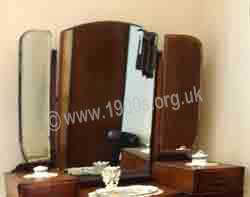
Dressing table mirrors, photographed at the Black Country Museum.
On the dressing table was a long, crocheted mat, known as a runner, probably crocheted by my grandmother, and on top of that was a 'vanity set'. This comprised two matching hand-mirrors and hairbrush, all backed with black ebony wood. In the better-off houses, the backing was embossed silver, but all I ever saw anywhere was black ebony wood, which was very much in fashion just before World War Two.
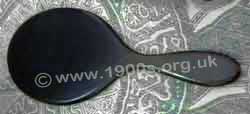
Dressing table hand mirror backed with black ebony wood. Photographed at the Lincolnsfields Children's Centre, Bushey.
The bed with its headboard, bedside cabinets and eiderdown
The bed was a standard double, 4 ft 6 inches wide.
The sheets and pillowcases were white linen, not cotton. I don't think I ever saw coloured sheets anywhere.
The blankets were thin cream-coloured wool and hemmed with blue blanket stitch.
The bedspread was a creamy grey fabric with a pattern woven into it.
On top was a gold-coloured eiderdown. This was completely standard, not unique to my parents' bed. They were in every master bedroom that I ever saw.
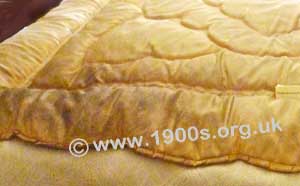
Eiderdown made of a shiny, silky material.
My parents' eiderdown was gold
coloured, as shown, photographed in the Straw House.
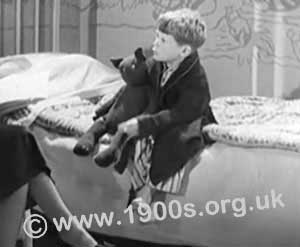
Child's eiderdown
I never had an eiderdown on my own bed, so I can't speak from experience. It does seem to me, though, that they must have been uncomfortable things. They were not unlike duvets except that they were thicker and quilted in a pattern, presumably filled with the soft downy feathers of the eider duck and of a size just to fit on the flat top surface of a bed. They were not wide enough to cover two people once they had got into bed, and I can only assume that couples were cold along one side and warm along the other. As they tossed and turned in their sleep, the eiderdown was bound to slip off one partner and even off the bed completely, because its shiny, silky material was slippery. As eiderdowns were used on the top of the bed, they never touched the body, which was fortunate since there was no way of washing them and they didn't have detachable covers.
There were dark oak bedside cabinets on either side of the bed, one for my father and one for my mother.
The headboard which was simply solid dark oak.
The bedroom floor
The floor was covered in the same dark brown marble-effect lino which was in all the rooms other than the bathroom, toilet and kitchen. It was thin compared with vinyl flooring and where there was a lot of use, such as where chairs and castors rubbed, it cracked, showing its heavy canvas backing.
One plain rectangular rug graced the floor.
The bedroom walls
The walls had picture rails, as illustrated on the parlour page, and there was a drop ceiling which was whitewashed. The walls were papered in a non-descript colour, and the woodwork - picture rails, window frames, window ledge, door, doorframe and skirting - were painted magnolia. Magnolia was a creamy-white, and in spite of my mother's polishing, I always thought that it made paintwork look dreary and did nothing to lighten the overall impression of the room.
The skirting was much taller and bulkier than in later houses. My parents always called it wainscoting, pronounced 'wainscoating'. The wainscoting of the Victorian terraces was higher still, up to about a metre.
The bedroom windows and curtains
The window was a bay one, which was common but not necessarily standard in suburban houses of the period. The dressing table was in the bay, but not completely set in, so allowing room behind for the curtains to be pulled.
The curtains were heavy brocade and the net curtains were mesh. I don't know why the net curtains were not lace-style net as it must have been available just before the war when my parents married. Perhaps what money they had went on other things so that by the time they could afford proper net curtains, no net was left in the shops because of the shortages of the war. Whatever the reason, the 'net' curtains were the sort of mesh developed to stick on the windows of the London Underground to prevent them shattering in bomb blast. Not that the mesh was stuck onto our bedroom windows: it was hung in several sections, loose like curtains. I have no idea how my parents got hold of it.
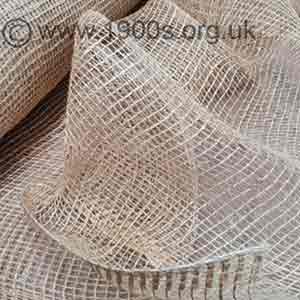
Net made to protect train windows in WW2, used as net curtains
Other items
There was a bedroom chair with dark wooden arms. I don't think it was ever used for sitting in; rather it was somewhere to lay out clothes for the following day.
There was no long mirror anywhere in the house, although if one positioned oneself carefully, it was possible to see almost all of oneself in one of the side mirrors of the dressing table.
Between the two chests of drawers was the gas fire, which I never saw lit, and over the fire was a mirror hanging from the picture rail.
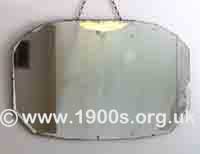
Mirror with bevelled edges hanging from the bedroom picture rail. Photographed in Tilford Rural Life Centre.
| sources | webmaster | contact |
Text and images are copyright
If you can add anything to this page or provide a photo, please contact me.



